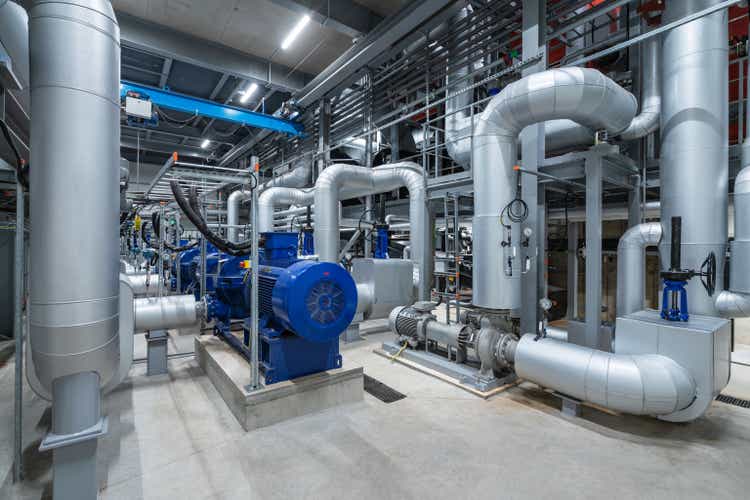imantsu/E+ via Getty Images
Pump manufacturer Gorman-Rupp (NYSE:GRC) didn’t see quite the same level of excitement when institutional investors piled into water-related stocks, and the shares have held up comparatively better as that sector has cooled. Basically flat now from my last update (but up as much as a third in the interim), the valuation is still in that “okay but not great” gray zone where it’s harder to make a definitive call either way.
There’s plenty to like about Gorman-Rupp, and not just its exposure to water infrastructure spending. The company is also leveraged to a coming recovery in new commercial construction, as well as infrastructure, and further growing in process-oriented industry. That said, the margins aren’t really exceptional and I do think that limits some of the upside.
Healthy Growth In Most Of Its Major Markets
Gorman-Rupp exited 2021 with solid momentum in the business. Revenue rose 14% in the fourth quarter of the year, with water-related businesses up 11% and non-water businesses up 22%. More encouraging still, the backlog climbed 65% from the prior year and 19% from the prior quarter, taking the company into this year with what I believe is the highest backlog in nine years.
Benchmarking companies in this space is always a little challenging because the end-market exposures and product line-ups make for less than “apples to apples” comparisons. Still, I think it’s instructive.
Xylem (XYL) saw high single-digit growth in its industrial-based businesses, with Water Infrastructure industrial up 10% and Applied Water industrial up about 7%. Xylem also saw relatively weaker results in its pump-driven utility business (down 2%).
IDEX (IEX) reported 7% growth in its Fluid & Metering Tech segment, and described its water business as “stable”, while end-markets like energy, chemicals, and ag all improved. Relative to Gorman-Rupp, IDEX’s FMT segment is considerably more exposed to short-cycle industrial, as well as oil/gas.
Franklin Electric (FELE) posted 23% growth in its Water Systems business, but while there are some overlaps with Gorman-Rupp in areas like municipal water and dewatering, the comparability is more limited given Franklin’s exposure to groundwater, those Franklin did note strength in dewatering and agriculture.
Finally, ITT (ITT) reported a 4% decline in its Industrial Process business, but 10% growth in its shorter-cycle industrial markets. Compared to Gorman-Rupp, ITT has little exposure to water (that went to Xylem years ago), and a lot more exposure to longer-cycle project-oriented businesses in verticals like chemicals and upstream oil/gas.
Considering the results and market outlooks from its peer group, I expect Gorman-Rupp to have a strong 2022 in terms of underlying demand. While supply chain and labor issues could still create some headaches in trying to meet that demand, I expect acceleration in markets like construction and industrial (particularly in HVAC, where the company has been gaining share and where companies like Carrier (CARR) will still have significant channel restocking). In the short term, I expect municipal water to be more “meh”, as projects tied to the infrastructure bill likely won’t really impact results until 2024.
Water As A Thematic Play
Gorman-Rupp’s leverage to the water infrastructure cycle is more mixed than some companies I’ve covered recently (like Xylem or Franklin Electric).
Flood and stormwater control is an area that will get earmarked funding support from the infrastructure bill, and that should be a solid opportunity for the company. Likewise with the company’s leverage to wastewater management. There is some leverage here to water supply as well, but it seems more oriented to rural uses, and I think Franklin is better-placed here.
Unfortunately, there’s really not the leverage here to opportunities like leak detection, real-time remote monitoring, sensor/software-enabled systems, and so on. Likewise, no exposure to filtration, treatment, or water quality beyond the fact that pumps are part of systems used to treat water. While this is painting with a broad brush, by and large companies more oriented to water quality assurance have gotten more investor attention than those leveraged to hardware meant to transport water/wastewater.
Outside of potable water, I do see Gorman-Rupp leveraged to further opportunities in dewatering, helped by improving non-resi construction and new infrastructure projects, and I do see the company having some further opportunities to grow in end-markets like mining.
The Outlook
Gorman-Rupp’s FY’21 results were rather close to what I expected from the company when I last wrote – revenue beat by 2%, EBITDA was about 5% light (greater impact from supply/labor pressures), and free cash flow was within 1%.
In the near term, I see better revenue growth opportunities on strength in construction, agriculture, and general industrial markets, with municipal demand likely to be more “okay” ahead of stimulus-driven new project starts. Margins are likely to remain more pressured in the short term, and I would expect to see the company take on some inventory to mitigate the supply chain challenges.
Longer term, not much has changed in my outlook. I do expect revenue growth to accelerate from its long-term average to around 4%, helped by municipal demand as well as opportunities like overseas fire suppression (where building codes are becoming more demanding). I believe FCF margins can improve back into the low double-digits as supply chain pressures ease, driving mid-to-high single-digit FCF growth (closer to 3% to 4% on a pre-pandemic normalized basis.
The Bottom Line
Discounted cash flow suggests a long-term total annualized return potential in the high single-digits, which isn’t bad for an industrial stock right now. Margin and return-based EV/EBITDA is less helpful given the supply chain pressures, but I’d say that the shares are modestly undervalued on a normalized basis.
Gorman-Rupp does offer some leverage to markets that I think are becoming more attractive, including construction and municipal water, but the stock is largely unfollowed and the historical margins and ROICs are more “good” than great. It’s not a bad idea as an overlooked play on improving end-markets, particularly with this pullback, but I don’t think it’s the best play today either.


Be the first to comment